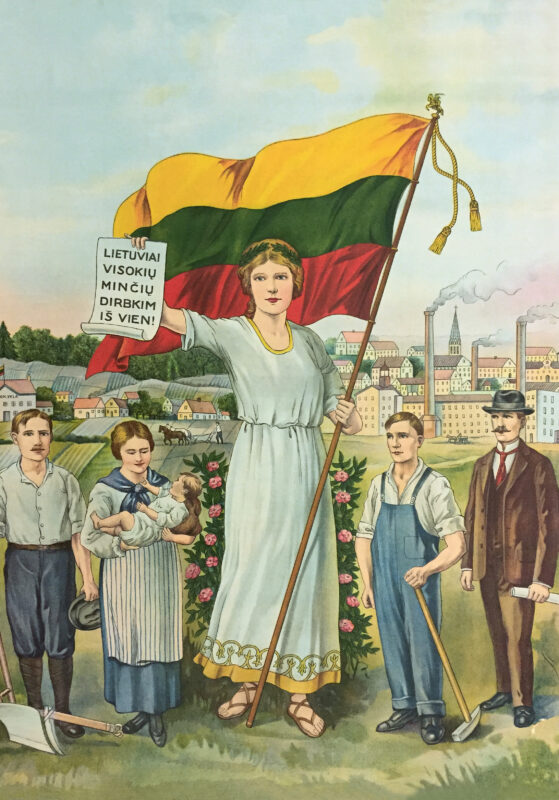100 Years in One Month: Lithuania as a Vision

A poster published by American Lithuanians invites all Lithuanians to work together for the future of the Homeland, USA, 1923. Collection of the Martynas Mažvydas National Library of Lithuania. The image is also available via www.epaveldas.lt
In 1795 the Polish-Lithuanian Commonwealth, called the Republic of Two Nations, collapsed after two hundred of its existence. It was divided by the monarchs of the neighbouring countries of Russia, Prussia and Austria. The greater part of the former territory of Lithuania found itself in the Russian Empire. The political elite from the old state fostered the hope of liberation more than once – in 1812 it supported the foray of Napoleon’s Great Army into Russia and even two unsuccessful armed uprisings, but ultimately all that was left of Lithuania by the second half of the 19th century was its name, the Lithuanian-speaking peasants and its landscape.
Lithuania’s statehood in the 19th century was a hazy concept. For some Lithuanians the search for a new Lithuania meant a search for a new Homeland. The first Lithuanian to come up with the idea of moving Lithuanians to Argentina was the folk thinker and poet Andrius Vištelis-Višteliauskas. Not long after, the doctor and writer Vincas Pietaris also proposed a similar course of action. Jonas Basanavičius, another doctor, suggested that his compatriots look back to the Thracians and the Phrygians for the beginnings of the Lithuanian nation. Ultimately, Lithuanian intellectuals understood that if they were to transport their Homeland, language and historical memory to somewhere else, Lithuania itself would cease to exist. And so they decided to create it themselves. To create a state with its own language and build its homes in its own landscape.
In order to achieve all that, everyone needed to agree on the fundamental principles as regards the existence of the Homeland. Towards this end, a Lithuanian congress, called the Great Seimas (Assembly) of Vilnius, was convened in Vilnius in 1905. Representatives of the Lithuanian nations, raising the demand for autonomy at the assembly, declared to the Russian Empire that they wanted to speak their own language and live in their own Homeland. However, living in one’s own Homeland did not necessarily mean living in one’s own State. At the beginning of the 20th century there were many visions of Lithuania as a state, some even cardinally opposed, but all of them were united in the goal of recreating the old or creating a new statehood, to no longer be dependent.
World War I, which had befallen their Homeland, tested the Lithuanian nation’s strength of resolve. The language survived. The landscape, even though seriously damaged, also. Even though the visions of Lithuania encountered the terrible reality of the war years, they also became stronger and grew not just in the mind of thinkers, but also in actual projects and proposals to the Germans, the new occupiers.
The Lithuanians understood that for them to remain in their own Homeland in perpetuity, they had to create their own state. With a parliamentary monarchy, a republic or even a socialist dictatorship under consideration, Lithuanian intellectuals finally managed to come to an agreement – the name of the state would be Lithuania. And so, the act of 16 February 1918 gave life to a modern Lithuania. The vision of Lithuania born in the minds of a group of intellectuals at the end of the 19th century, a vision that had visited several continents and millions of Lithuanians in the world, that had taken on the legacy of European democracy, but not forgotten its own national and cultural heritage, finally emerged out of the mist and came into being.
Eligijus Raila